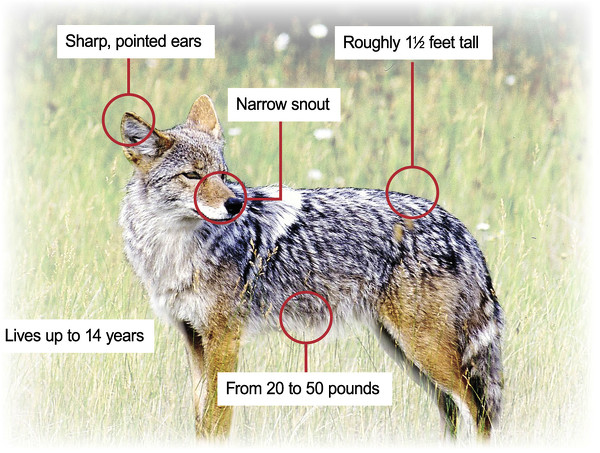Friday, November 12th, 2021
Urban Coyotes: They're closer than you think
The wild animals have been spotted in every Ohio county
By Sydney Albert

Photo by Bill Thornbro/The Daily Standard
These distinguishing characteristics help identify the adult coyote.
Sources: Ohio Department of Natural Resources, Ohio State University, Purdue University, National Geographic, Wikipedia
ST. MARYS - Coyote sightings close to town may cause a stir yet the wild dogs are typically afraid of humans and attacks are generally avoidable, according to experts.
Though originally native to the open plains and deserts of the West, coyotes have spread across the nation as other large predators and competitor species are on the decline.
They're hardly new to Ohio, where there have been sightings reported in every county. Their ability to exploit almost any habitat has at times brought them into close contact with humans.
While most wildlife species avoid developed areas and often decline in numbers as a result of human expansion, coyotes seem to have thrived, according to the Ohio Department of Natural Resources. Reports of coyotes making homes in metropolitan areas like Chicago have drawn much interest, while cases of attacks involving pets and small children alike - from San Francisco Bay to Cape Cod - have stoked fears.
Yet while coyotes have become common in both urban and rural settings, researchers and local wildlife officers say conflict can usually be avoided.
Marck Schemmel, a wildlife officer for Auglaize County, said he wouldn't put it past coyotes to linger on the outer edges of developed areas such as St. Marys, citing their adaptable nature. Even so, coyotes are typically still fearful of humans and avoid them when possible. The animals are mostly nocturnal, becoming more active when most people tend to be asleep.
Coyotes are omnivorous and feed on small mammals, vegetables, nuts and carrion, according to ODNR. If left unchecked, livestock - particularly sheep and chickens - can also become prey, the department reports.
Cats and small dogs are typically not targeted, Schemmel said, perhaps in part because of their closer association with humans. But a good rule of thumb is to not let animals roam freely or without supervision.
Stanley D. Gehrt, a professor at The Ohio State University and Wildlife Extension specialist, also supervises many aspects of the Urban Coyote Research Project, which focuses on studying the coyote population in Chicago.
Gehrt, in a research paper co-authored by Lynsey A. White, found that of 142 reported coyote attacks on people in the United States and Canada, most occurred in California.
In separate documents, Gehrt noted that issues tend to arise in areas of high human activity when coyotes become habituated to people, losing their natural fear, or due to food conditioning.
About 70% of the incidents studied by Gehrt took place on or adjacent to victims' homes. Breaking down the details further, Gehrt noted 37% of the attacks were actively predatory, while 22% involved coyotes exhibiting investigative behavior, biting people who may have been napping on their extremities or attempting to steal items such as lunch bags.
Other incidents involved small pets that acted as a draw for coyotes. There were also defensive incidents, where the animals had been cornered or were defending pups, rabid incidents and unknown causes.
However, the presence of coyotes doesn't always lead to attacks and most coyotes don't come into conflict with people, Gehrt has noted.
Coyotes can become nuisance animals once they've been fed by humans, either intentionally or unintentionally. Free-ranging cats and feral cat colonies may also attract coyotes to residential areas.
If people suspect they have coyotes in their area and want to discourage activity, Schemmel recommends removing any potential attractants in their yard, whether it be pet food or garbage. He also suggested people tidy their grills and drip pans, as coyotes are known to frequent them.


